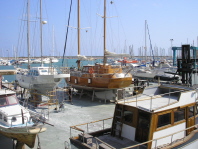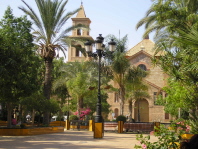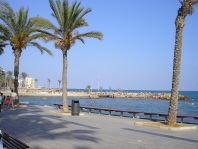

Torrevieja Information


Torrevieja Information
Links to Other Pages
Home - Costa Blanca Property
Costa Blanca Apartments
Costa Blanca Houses
Costa Blanca Villas
Bungalows
Costa Blanca Maps
Airport Transfers
Costa Blanca Rentals
Contact.
Buy Spanish Property Direct From the Owner
Travel Articles
Costa Blanca Information
Links to Other Pages
Home - Costa Blanca Property
Costa Blanca Apartments
Costa Blanca Houses
Costa Blanca Villas
Bungalows
Costa Blanca Maps
Airport Transfers
Costa Blanca Rentals
Contact.
Buy Spanish Property Direct From the Owner
Travel Articles
Costa Blanca Information

Torrevieja Information - Every year many thousands of holidaymakers from Spain and in fact all over Europe flock to the Costa Blanca town of Torrevieja. It's excellent range of facilities, its fine sandy beaches and its vibrant atmosphere all help to make it a popular choice with tourists. Formerly a small fishing village, Torrevieja became one of the major salt exporters in the world, thanks to the two large salt lakes located behind the town. An explosion in property development during the 1980’s and 1990’s caused the town to grow at a tremendous rate.
Torrevieja Information - Torrevieja and the Vega Baja



Pilar de la Horadada - Built around an ancient watchtower that has stood since the 14th Century, Pilar de la Horadada (‘The Drilled One’) is the southernmost coastal resort of the Costa Blanca. To the south lies the Mar Menor (‘Lesser Sea’) and the Costa Calida (‘Warm Coast’). The watchtower, similar to many others along the coast, was built to warn of attacks from Berber pirates who sailed this coastline many centuries ago. Today a popular seaside town with fine sandy beaches, Pilar de la Horadada is also a great area for nature lovers and the nearby Rio Seco (‘Dry River’), boasts a wide variety of flora and fauna including some species of wild orchid and some endangered species of dwarf palms.
Formentera del Segura - Originally a Moorish village, Formentera del Segura was conquered by the Christian king Jaime I (‘The Conquistador’) in 1242, the village changed hands a number of times over the prevailing centuries until 1730 when it came under control of Nicolas Pérez de Sarrio (The Lord of Formentera), who gave the village its current name. Largely destroyed by the great earthquake of 1829, Formentera del Segura was re-built by 1840 culminating in the building of the parish church. Relying mostly on agriculture and citrus farming for its survival Formentera del Segura benefits from an irrigation system put into place by the Moors centuries ago. One of its most popular fiestas is ‘The Day of the Bicycle’ featuring a race involving many of its inhabitants.
Rojales - A pretty village located on the banks of the Segura river, Rojales has been able to keep its traditional Spanish feel, despite the onslaught of tourism and property development. With a history stretching back to the Arab Occupation, Rojales still has evidence of irrigation systems put into place by the Moors during their time in the area. Worth visiting while in Rojales are the Water Wheel, the Azud, the Charles III bridge and the Gasparito Wells, also worth a look are the cave houses at El Rodeo, where a regular craft market is held.
Algorfa - In the middle of citrus farming country, Algorfa is a small village with a big heart, its warm friendly people always have a smile for visitors. Located close to the larger village of Almoradi, Algorfa is most noted for its La Finca Golf Club, with its wonderful par 72 golf course designed by Jose Gancedo. Just outside the village is an unusual nineteenth century neo-gothic church. Algorfa’s traditional market is held every Sunday and is a great place to spend an hour or two hunting for bargains and locally grown fresh produce.
Orihuela - The capital of the Vega Baja region of the Alicante province, Orihuela is an ancient town with a long and distinguished history. Though there were settlements in the area during the Bronze Age, Orihuela came into its own during the Roman occupation when it was known as Auraiola, later an important headquarters for the Moors under Teodomiro it was re-conquered for the Christians in 1296. Recognised for its large number of beautiful churches, palaces and monasteries, Orihuela also has several museums that are worth visiting while in the town.
Benferri - The delightful village of Benferri is ideally located in a triangle between Alicante, Murcia and Orihuela, it is one of the Vega Baja (Low Fertile Valley) villages situated in rich citrus farming country. The land around Benferri was irrigated first by the Romans and later by the Arabs during the Muslim occupation (eighth to thirteenth centuries) making the soil perfect for the growing of fruit and vegetables. The original village was set up by James Rocamora in 1494, he built 29 dwellings for 29 families to live and work in the village - his work was carried on by his son Jeronimo de Rocamora, the church of San Jeronimo still stands today.
Callosa de Segura - Overlooked by the surrounding Sierra de Callosa mountains, the medium sized town of Callosa de Segura features some of the oldest buildings in the Alicante province. The land around Callosa de Segura, irrigated by the Segura river is rich and fertile, and perfect for the growing of vegetables and citrus fruits. One of its most interesting buildings is the Saint Roque Hermitage which took over 200 years to construct (1579-1798) and was built on the exact spot where the Patron Saint Roque is said to have appeared. Also noted for hemp and hemp products Callosa de Segura has a Hemp Museum which describes the production of hemp from seed to final product.
Map of Torrevieja - Torrevieja Weather - Torrevieja Apartment - Torrevieja Marina - Torrevieja Information
Do you have a property to sell or rent in Torrevieja? Try advertising with us - Advertise My Torrevieja Property
Formentera del Segura - Originally a Moorish village, Formentera del Segura was conquered by the Christian king Jaime I (‘The Conquistador’) in 1242, the village changed hands a number of times over the prevailing centuries until 1730 when it came under control of Nicolas Pérez de Sarrio (The Lord of Formentera), who gave the village its current name. Largely destroyed by the great earthquake of 1829, Formentera del Segura was re-built by 1840 culminating in the building of the parish church. Relying mostly on agriculture and citrus farming for its survival Formentera del Segura benefits from an irrigation system put into place by the Moors centuries ago. One of its most popular fiestas is ‘The Day of the Bicycle’ featuring a race involving many of its inhabitants.
Rojales - A pretty village located on the banks of the Segura river, Rojales has been able to keep its traditional Spanish feel, despite the onslaught of tourism and property development. With a history stretching back to the Arab Occupation, Rojales still has evidence of irrigation systems put into place by the Moors during their time in the area. Worth visiting while in Rojales are the Water Wheel, the Azud, the Charles III bridge and the Gasparito Wells, also worth a look are the cave houses at El Rodeo, where a regular craft market is held.
Algorfa - In the middle of citrus farming country, Algorfa is a small village with a big heart, its warm friendly people always have a smile for visitors. Located close to the larger village of Almoradi, Algorfa is most noted for its La Finca Golf Club, with its wonderful par 72 golf course designed by Jose Gancedo. Just outside the village is an unusual nineteenth century neo-gothic church. Algorfa’s traditional market is held every Sunday and is a great place to spend an hour or two hunting for bargains and locally grown fresh produce.
Orihuela - The capital of the Vega Baja region of the Alicante province, Orihuela is an ancient town with a long and distinguished history. Though there were settlements in the area during the Bronze Age, Orihuela came into its own during the Roman occupation when it was known as Auraiola, later an important headquarters for the Moors under Teodomiro it was re-conquered for the Christians in 1296. Recognised for its large number of beautiful churches, palaces and monasteries, Orihuela also has several museums that are worth visiting while in the town.
Benferri - The delightful village of Benferri is ideally located in a triangle between Alicante, Murcia and Orihuela, it is one of the Vega Baja (Low Fertile Valley) villages situated in rich citrus farming country. The land around Benferri was irrigated first by the Romans and later by the Arabs during the Muslim occupation (eighth to thirteenth centuries) making the soil perfect for the growing of fruit and vegetables. The original village was set up by James Rocamora in 1494, he built 29 dwellings for 29 families to live and work in the village - his work was carried on by his son Jeronimo de Rocamora, the church of San Jeronimo still stands today.
Callosa de Segura - Overlooked by the surrounding Sierra de Callosa mountains, the medium sized town of Callosa de Segura features some of the oldest buildings in the Alicante province. The land around Callosa de Segura, irrigated by the Segura river is rich and fertile, and perfect for the growing of vegetables and citrus fruits. One of its most interesting buildings is the Saint Roque Hermitage which took over 200 years to construct (1579-1798) and was built on the exact spot where the Patron Saint Roque is said to have appeared. Also noted for hemp and hemp products Callosa de Segura has a Hemp Museum which describes the production of hemp from seed to final product.
Map of Torrevieja - Torrevieja Weather - Torrevieja Apartment - Torrevieja Marina - Torrevieja Information
Do you have a property to sell or rent in Torrevieja? Try advertising with us - Advertise My Torrevieja Property
© Needahand Spanish Properties 2007 - Torrevieja Information